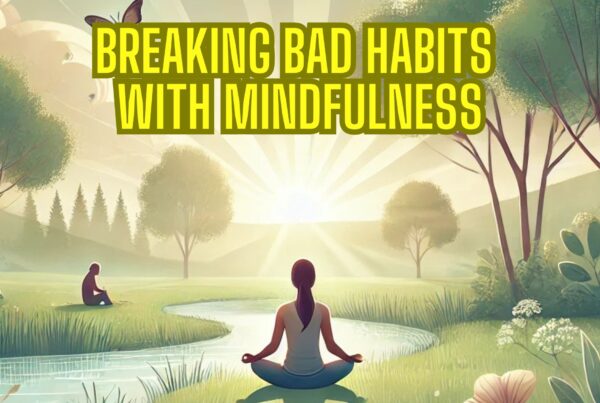Mindfulness for Beginners: A Guide to Starting and Sustaining Your Practice
Mindfulness has become a buzzword in recent years, but its roots go back thousands of years, grounded in the simple yet profound act of being present. Our world is full of distractions and it’s easy to feel scattered, constantly chasing the next task, notification, or goal. Mindfulness offers a chance to slow down, breathe, and meet the present moment with open curiosity. Many might feel overwhelmed at the thought of how to even start a mindfulness practice. In this blog, we explore mindfulness for beginners and how to build a sustainable practice.
This guide will help you understand what mindfulness truly is and how to start practicing it in a way that feels achievable and meaningful. Whether you’re new to mindfulness or someone who has tried it but struggled to maintain a consistent practice, we’ll explore not just the basics but also common challenges and how to overcome them.
What is Mindfulness?
Mindfulness is the practice of bringing your full attention to the present moment, without judgment. It’s about becoming aware of what’s happening—both internally and externally—right here, right now. Many people mistakenly believe that mindfulness is about “clearing the mind” or reaching a state of perpetual calm. In reality, mindfulness is about noticing your thoughts, feelings, and sensations with curiosity and acceptance.
Scientifically, mindfulness has been shown to change the structure of the brain. Studies using MRI scans reveal that regular mindfulness practice can increase the density of grey matter in areas of the brain associated with attention, learning, and emotional regulation. Put simply, mindfulness helps us respond to life rather than react to it.
“Mindfulness isn’t about controlling your thoughts—it’s about not letting them control you.”
How to Start a Mindfulness Practice
Starting a mindfulness practice can feel daunting, especially with so many techniques out there. The good news? Mindfulness is simple—so simple, in fact, that it might feel too easy at first! But like any skill, it requires practice.
1. Take a Good Seat
Sit in a way that’s comfortable but not slouching. You can sit on a chair with your feet flat on the ground or on a cushion with your legs crossed. The important thing is to find a position where you feel stable and relaxed, yet alert.
2. Pay Attention to Your Breath
Close your eyes (or keep them softly open) and begin to notice your breath. You don’t need to change it—just observe the natural rhythm of your inhalations and exhalations. Your breath is your anchor, always available to bring you back to the present.
3. When Your Mind Wanders, Come Back
Here’s the catch: your mind will wander. It might race off to your to-do list, a conversation you had yesterday, or what’s for dinner. That’s normal! Each time you notice your mind has wandered, gently bring your attention back to the breath. This act of returning is the essence of mindfulness.
When People Try Mindfulness
It isn’t uncommon for me to hear my clients say that they tried a mindfulness practice but stopped because of one of a handful of reasons. These include:
- Too Many Thoughts: “I stopped because there were too many thoughts and I couldn’t stop them.” Yes, and this is exactly why we need to practice mindfulness! Mindfulness allows us to build the practice of noticing and acknowledging the thought and letting it go.
- I Tried It Once: “I tried it once or twice and nothing really happened.” If you went to the gym once or twice, would you expect to have the perfect body? Mindfulness is about taking your mind to a mental gym and working it out. Like Neuroplasticity, the more you practice this habit, the more you offer your brain a new way to think.
- It’s Boring: “I just find it really boring!” Boredom is becoming a massive discomfort for people. Learning how to be able to sit with discomfort is a skill that can serve you well in life. If focusing on ‘the breath’ isn’t for you, try a different form of mindfulness practice.
Creating a Routine That Sticks
One of the most common challenges for beginners is building a consistent practice. Life is busy, and sitting down for five minutes of meditation can feel like an impossible luxury.
Start Small
You don’t need to meditate for an hour every day. Start with just five minutes. The key is consistency. A short daily practice is far more powerful than an occasional long session.
Find a Trigger
Attach your mindfulness practice to an existing habit. For example, meditate right after brushing your teeth or before you start your morning coffee. This makes it easier to integrate mindfulness into your daily routine.
Be Flexible
Some days, you may feel too tired or busy to meditate. That’s okay. Try a mindful walk instead, or simply take three deep breaths during a break. Mindfulness is always available—you just need to pause and notice it.
Common Challenges in Mindfulness Practice
1. Wandering Thoughts
Your mind will wander. It’s what minds do. Rather than fighting it, treat each wandering thought as an opportunity to practice returning to the present.
2. Discomfort and Restlessness
Sitting still can be uncomfortable. If you notice pain or restlessness, try shifting your attention to the sensations in your body. Is the discomfort sharp or dull? Does it change as you observe it? Sometimes curiosity can transform discomfort into something interesting.
3. Boredom
Meditation can feel boring at first because we’re so used to constant stimulation. Instead of fighting boredom, lean into it. Observe it. You might find that it softens into something else—perhaps calm or clarity.
Practical Solutions to Overcome Challenges
1. Use Multiple Anchors
If focusing on the breath feels too difficult, try using other anchors like sound, body sensations, or visual objects in your environment. Mindfulness doesn’t have to be limited to sitting meditation.
2. Adjust Your Posture
If you’re feeling drowsy, sit with a straighter back or try standing meditation. Conversely, if you’re too tense, soften your posture a little.
3. Practice Self-Compassion
Mindfulness is not about being perfect. Every time your mind wanders, treat yourself with kindness. Imagine speaking to yourself the way you’d encourage a friend.
Mindfulness for Beginners
Mindfulness is a lifelong journey. It’s not about achieving a particular state but about showing up for yourself, moment by moment. Start small, be curious, and above all, be kind to yourself. The beauty of mindfulness is that there’s no “right” way to do it—only your way. So take a deep breath, and begin again.
FAQs: Mindfulness for Beginners
- What is mindfulness?
- Mindfulness is the practice of bringing your attention to the present moment without judgment. It involves observing your thoughts, feelings, and surroundings with curiosity and acceptance.
- How do I start a mindfulness practice?
- You can start by setting aside five minutes a day to focus on your breath. Sit comfortably, close your eyes, and notice your breath as it moves in and out. Each time your mind wanders, gently bring your focus back to the breath.
- Do I need special equipment to practice mindfulness?
- No, you don’t need any special equipment. A quiet space and a comfortable chair or cushion are enough. Mindfulness can be practiced anywhere—while walking, eating, or simply sitting.
- Why does my mind wander so much during meditation?
- It’s perfectly normal for your mind to wander. The act of noticing that your mind has wandered and gently bringing it back to the present is the core of mindfulness practice.
- What are the benefits of mindfulness?
- Mindfulness has been shown to reduce stress, improve focus, enhance emotional regulation, and promote overall well-being. Regular practice can help you respond to life’s challenges with greater calm and clarity.
- How can I make mindfulness a habit?
- Start small and be consistent. Attach mindfulness to an existing habit, such as brushing your teeth or having your morning coffee. Even a few minutes a day can make a difference.
Download a FREE Mini-Mindfulness Meditation Here!
Release Hypnosis Melbourne Hypnotherapy
Since 2015, Lawrence Akers has been working under the name Release Hypnosis offering Hypnotherapy and ACT based work to the people of Melbourne or an online service. Based on St Kilda Rd, Release Hypnosis is an easy and convenient location to get to and accessible by the ANZAC station train and tram stop. Release Hypnosis can help with a wide range of presenting issues, and I offer a free 30 minute no obligation discovery call for those who are unsure if hypnotherapy is the right way forward for them.
Book Your FREE 30 Minute Consultation With Release Hypnosis NOW!
You may also like to read:
The Mindfulness Toolkit
Breaking Bad Habits with Mindfulness: A Path to Lasting Change
Mindfulness Meditation for Anxiety: A Step-by-Step Guide
Mindful Eating: 5 Tips to Successfully Manage Your Weight








